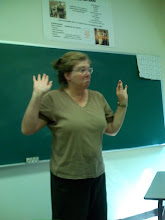After Trinidad we went to Dominica (pronounced doh mu NEE kuh, just like in the singing nun song), where I was out of commission for much of the day with the viral bug that's been going around. About 3pm, after Bibb came back from his excursion, we walked around a bit, very s-l-o-w-l-y. Seems not too touristy, pretty small, worth another visit, but I basically don't have very many memories of that particular site.
The next day, fully recovered, I had a GREAT time on St. Kitts, where we took a Jeep Adventure which focused on the history of sugar production on the island. The tour operator, Greg, is a 5th generation Kittitian (that's what they call themselves, according to the guide book) and has dual citizenship with Canada. He went there to get a degree in hotel-entertainment-management, and now runs several different kinds of tours, using Land Rovers.
We visited several defunct sugar plantations and processing sites, and he gave very well-informed talks about the slave labor that produced the crops and how the wealth was basically bled off to Europe, where it fueled the Industrial Revolution. The govt of St. Kitts took over the sugar industry in 1974 and basically bought out much of the land, and the last sugar processing facility just closed in 2005. The island is still struggling to find a new economic mix that will support its people. Greg showed us housing that's being built for some of the many landless people and talked about how he hopes his county will choose to develop tourism in a healthy way. Very socially conscious and progressive picture of the island, delivered along with amazing scenery, fresh breezes, a sampling of exotic fruits.
Today we spent on St. Croix, which is actually US soil, since it's part of the US Virgin Islands, so we were able to get dollars from bank machines for the first time in almost three weeks! I love travel, but familiar money also makes me happy : )
I went on a bus tour (the first time I'd ridden in air conditioning for quite a while) that went to two more former sugar plantations, but very different from St. Kitts' tour. At the first one, the main houses are being stabilized and made safe for tours, so you can't go in, and the outbuildings where cane was processed into sugar, molasses and rum are mostly in ruins, though you can see outlines. The tour guides, though, focus on the present plantings, identifying trees, flowers, vines and cacti that either grow naturally there or have been planted (though they are all native to the area). That was interesting, but I learned more from Greg. The second plantation home, though, still belongs to the same family -- since it was built in 1896! -- and three generations of the family participated in our guided tour. A couple from Denmark ran the cane plantation, and the house is still in marvelous shape and has furniture from around 1900; the family doesn't live there, but they have family pictures of the various generations.
This island is drier, but in the higher elevations they have rainforest-like growth. Not true rainforest, since there's far too much light getting to the ground level, but still pretty lush. After the tour I had a shower and walked into the small town where we docked, Frederickstad, and had lunch with a Canadian couple I ran into. (Was supposed to hook up with Bibb, but his tour was running late and we missed each other.) We ate shrimp with a local dish called fungi, pronounced foon-shay I think, that is made from calabash (a squash-type plant) but has an almost rice consistency. Tasty, anyway. And a local beer, Presidente.
Now we are chugging toward the Dominican Republic, then a day at sea, then Florida and the drive home. This has been so intense, in so many ways, it's hard to believe that it's almost over, and hard to believe that Christmas and New Year's happened, it was so warm and so busy.
More soon.
